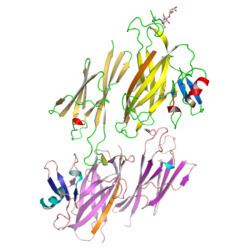Entrez 7784 | Ensembl ENSG00000188372 | |
 | ||
External IDs OMIM: 182889 MGI: 99215 HomoloGene: 5178 GeneCards: ZP3 | ||
Zona pellucida sperm-binding protein 3, also known as zona pellucida glycoprotein 3 (Zp-3) or the sperm receptor, is a protein that in humans is encoded by the ZP3 gene. ZP3 is the receptor in the zona pellucida which binds sperm at the beginning of fertilization.
Function
The zona pellucida (ZP) is a specialized extracellular matrix that surrounds the oocyte and early embryo. It is composed of three or four glycoproteins (ZP1-4) with various functions during oogenesis, fertilization and preimplantation development. The protein encoded by this gene is a major structural component of the ZP and functions in primary binding and stimulation of the sperm acrosome reaction. The nascent protein contains a N-terminal signal peptide sequence, a conserved ZP domain, a consensus furin cleavage site (CFCS), a polymerization-blocking external hydrophobic patch (EHP), and a C-terminal transmembrane domain. Cleavage at the CFCS separates the mature protein from the EHP, allowing it to incorporate into nascent ZP filaments. A variation in the last exon of this gene has previously served as the basis for an additional ZP3 locus; however, sequence and literature review reveals that there is only one full-length ZP3 locus in the human genome. Another locus encoding a bipartite transcript designated POMZP3 contains a duplication of the last four exons of ZP3, including the above described variation, and maps closely to this gene.
